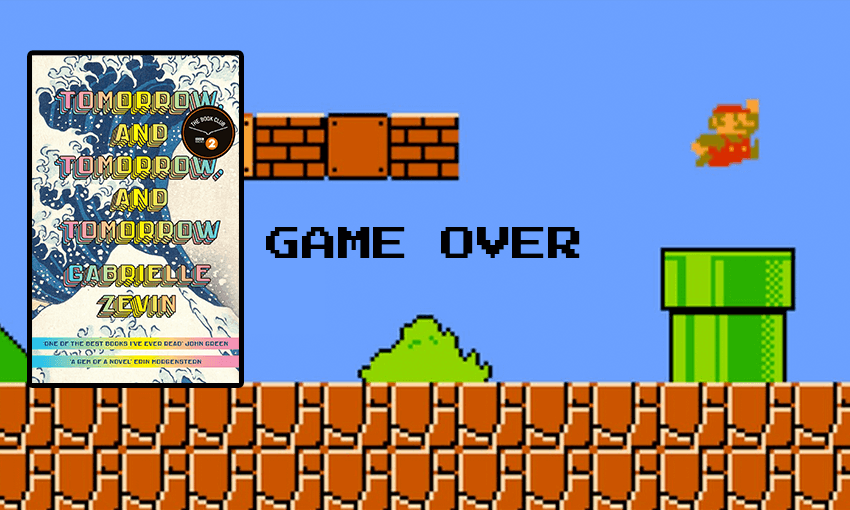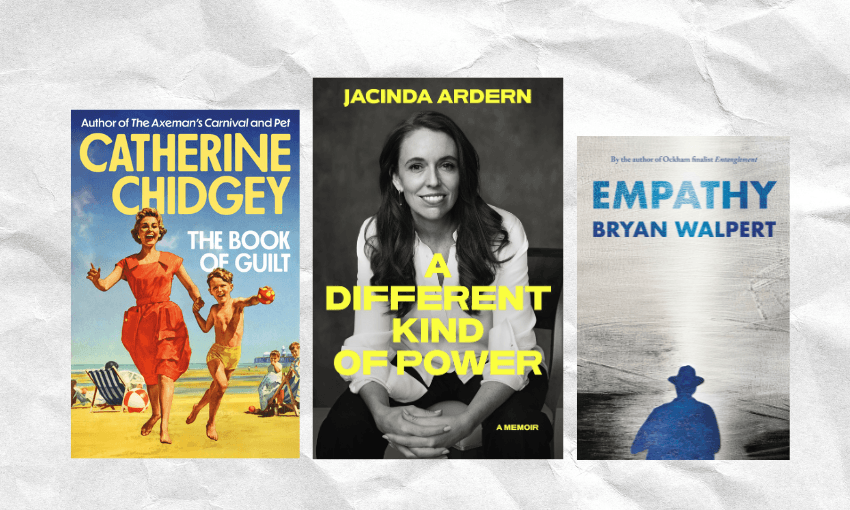Gabrielle Zevin’s novel about friendship in the gaming industry has received rave reviews, but Sam Brooks finds enough gremlins and glitches to amount to a failure on almost every level.
There are two pieces of art that came to mind when I was reading Gabrielle Zevin’s new novel Tomorrow, and Tomorrow, and Tomorrow (hereafter TTT for obvious reasons).
The first is Ready Player One, Ernest Cline’s wish fulfilment sci-fi that was later improved on by Steven Spielberg’s film. Tomorrow, and Tomorrow, and Tomorrow features, at its heart, two people, Sam and Sadie, who bond over Super Mario when the former is recovering from a traumatic car accident. They have a falling out, but then reconnect in university and end up working in game development together, a friendship that Zevin follows from both sides of the story.
It compares favourably to Cline’s novel, admittedly. Zevin’s protagonists are very rarely toxic, and when they behave badly, the people around them react accordingly. This novel is only nakedly manipulative a few times. It’s when Zevin throws in a pop culture reference that it feels the most like Cline’s magnum opus (not a compliment). Every reference lands with a hollow thunk, the assumption of meaning rather than the resonance of depth.
That’s because TTT, even outside the title, features close to 100 distinct pop culture references in its 350-odd pages. To wit: Metal Gear Solid, Twelfth Night, Joni Mitchell’s ‘River’, Tetris, The Hero’s Journey, The Legend of Zelda, The White Album, General Hospital, The Matrix, Ghost in the Shell, Baz Luhrmann’s ‘Everybody’s Free (To Wear Sunscreen)’. And so on and so forth.
These are not specific pop culture references – being familiar with these references indicates that a character simply exists in the world. These are some of the most ubiquitous and well-loved pieces of culture of the past 30 years. It’s a technique, if it can be called that, that draws from the Tumblr era; where one defined their personality, and their sense of self, by what art they liked, rather than what they did or who they were. Using references to define one’s character, or characters in this case, isn’t inherently bad, but it’s a flimsy shortcut and one that fails to suggest depth or specificity indicating character depth and idiosyncrasy.
When Sadie and Sam bond over Super Mario in the hospital, that’s a character building moment. It’s a moment where we understand the kind of kid who refuses to speak to anybody else in the hospital because he is entirely submerged in his video game, until another kid in the hospital happens upon him playing it, and she happens to love the game. They bond over it. It’s lovely, actually.
By the time the novel ends, Sadie and Sam are barely distinct from any adult born in the 80s who have any vague interest in pop culture. Even more egregious, they are barely distinct from anybody who has a vague interest in gaming. The most obscure game referenced is Suikoden, the cult JRPG from the 90s, and even then that is dropped as one title in a clunky list. One reference can help us understand a character, a little kick of flavour to help define a dish. One hundred references gives us all flavour, and you end up forgetting any sense of a dish entirely.
Which brings me to the other reference point that scratched the back of my mind while reading: Richard Linklater’s Before series. The films, which check in on a couple, Jesse and Celine, every nine years, are an often raw look at how age, time and love collide with each other, sometimes beautifully, often not.
TTT follows Sam and Sadie through 20 years of friendship. They make games together with their friend Marx Watanabe (sure), they have heartbreaks, professional and private setbacks and yes, even tragedy. Zevin tells this with detached omniscience, occasionally taking us out of the present day to drop in a quote from a future interview or TedTalk. It’s a clever trick, and allows her to build these characters outside of their own perspective.
It also leads to some distractingly flat prose. Take this, from about halfway through the book, when Sadie is 23.
“She liked to be comfortable. She liked hotel rooms, thick towels, cashmere sweaters, silk dresses, oxfords, brunch, fine stationery, overpriced conditioner, bouquets of gerbera, hats, postage stamps, art monographs, maranta plants, PBS documentaries, challah, soy candles and yoga. She liked receiving a canvas tote bag when she gave to a charitable cause. She was an avid reader (of fiction and non-fiction), but she never read the newspaper, other than the arts sections, and she felt guilty about this. Dov often said she was bourgeois. He meant it as an insult, but she knew that she probably was. Her parents were bourgeois, and she adored them, so, of course, she had turned out bourgeois, too.”
Sure, it’s an economical way to convey information. But it feels like just that – a list of qualities that really, could be anybody. The Before series is profound because of how wildly specific Jesse and Celine’s relationship is; how their relationship spools out from that first chance meeting in Vienna. We feel for them so hard because we see ourselves in their strange little quirks, like looking through a window and accidentally catching your own reflection. We relate, a little too hard.
Zevin goes too far in the other direction: by making Sadie feel like everywoman, she feels like literally no woman. (This is especially disappointing, given Zevin wrote the excellent, underseen indie film Conversations with Other Women, which leans hard into the Before trilogy’s territory.) Sam fares a little better, and Zevin’s sympathies seem to lie here rather than with Sadie; Sam’s traumatic backstory (car accident, dead parent) gets more focus, while Sadie’s trauma (abusive relationship, pregnancy woes) is limited to the present. By the end of the story, it’s hard to tell why we’re following these characters and their journey together at all; they seem linked together only by virtue of being in the same pages, not because anything that has been written convinces us they should be together. People don’t interact like this unless someone is writing toward a foregone conclusion.
Unfortunately, Zevin’s flat writing isn’t reserved only for her characters. It’s throughout the book. Action and plot are written as though they’re going to be adapted for screen later, which is true in this case; the rights were snapped up over a year before the novel was even released. Dialogue is strictly economical, characters diagnose each other and themselves (“I am, as you know a bottomless pit of ambition and need)”, like shady tweets from people who are too online. Interiority is sacrificed for swift action, showing everything and telling us nothing. Although, I’m not sure if I’d prefer reading the interior lives of these characters based on the rest of the writing.
This frankly, extends to the entire conceit. A book about the journey of two developers who come together as close friends through their love of gaming, and their various ups and downs in the industry, is a great idea. However, Zevin’s execution almost entirely dances around realities that we now know to be deeply ingrained in the game industry – sexism, racism, worker exploitation – to tell a story that really, could be about any industry. One eleventh hour incursion into an actual game (that so badly misunderstands how MMORPGs and communication therein works) doesn’t fix that. The game industry feels like an unshapely tote bag, unsuited to carry anything that Zevin has bunged into it.
When I got to the end of Tomorrow, and Tomorrow, and Tomorrow, I felt like I’d gotten to the end of a bad game. A game that had promise, but in which a litany of glitches, design flaws and awkward mechanics distracted me from anything that might’ve been good about it. We can forgive a glitchy game if the soul is there. If it’s not there, all you’ve got is a bad game. Tomorrow, and Tomorrow, and Tomorrow is a failure on pretty much every level, but if it had a little bit more soul (and frankly, a lot more craft), it’d be fine.
The film might still be decent, though.



